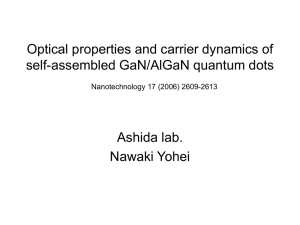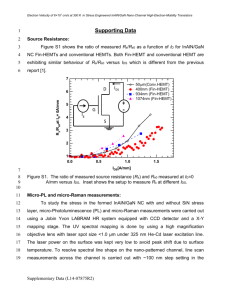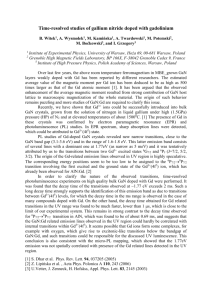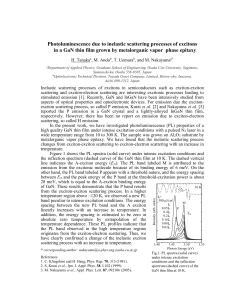Zikova_clanek_NoveHrady
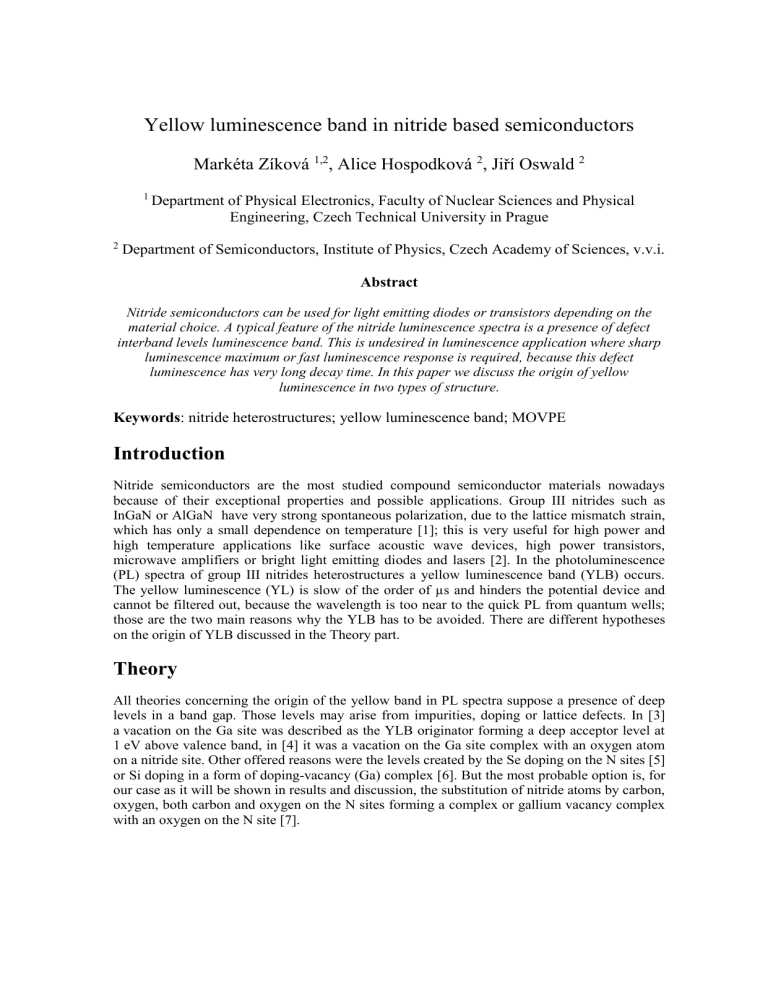
Yellow luminescence band in nitride based semiconductors
Markéta Zíková
1,2
, Alice Hospodková
2
, Jiří Oswald
2
1
Department of Physical Electronics, Faculty of Nuclear Sciences and Physical
Engineering, Czech Technical University in Prague
2
Department of Semiconductors, Institute of Physics, Czech Academy of Sciences, v.v.i.
Abstract
Nitride semiconductors can be used for light emitting diodes or transistors depending on the material choice. A typical feature of the nitride luminescence spectra is a presence of defect interband levels luminescence band. This is undesired in luminescence application where sharp luminescence maximum or fast luminescence response is required, because this defect luminescence has very long decay time. In this paper we discuss the origin of yellow luminescence in two types of structure.
Keywords : nitride heterostructures; yellow luminescence band; MOVPE
Introduction
Nitride semiconductors are the most studied compound semiconductor materials nowadays because of their exceptional properties and possible applications. Group III nitrides such as
InGaN or AlGaN have very strong spontaneous polarization, due to the lattice mismatch strain, which has only a small dependence on temperature [1]; this is very useful for high power and high temperature applications like surface acoustic wave devices, high power transistors, microwave amplifiers or bright light emitting diodes and lasers [2]. In the photoluminescence
(PL) spectra of group III nitrides heterostructures a yellow luminescence band (YLB) occurs.
The yellow luminescence (YL) is slow of the order of µs and hinders the potential device and cannot be filtered out, because the wavelength is too near to the quick PL from quantum wells; those are the two main reasons why the YLB has to be avoided. There are different hypotheses on the origin of YLB discussed in the Theory part.
Theory
All theories concerning the origin of the yellow band in PL spectra suppose a presence of deep levels in a band gap. Those levels may arise from impurities, doping or lattice defects. In [3] a vacation on the Ga site was described as the YLB originator forming a deep acceptor level at
1 eV above valence band, in [4] it was a vacation on the Ga site complex with an oxygen atom on a nitride site. Other offered reasons were the levels created by the Se doping on the N sites [5] or Si doping in a form of doping-vacancy (Ga) complex [6]. But the most probable option is, for our case as it will be shown in results and discussion, the substitution of nitride atoms by carbon, oxygen, both carbon and oxygen on the N sites forming a complex or gallium vacancy complex with an oxygen on the N site [7].
Results and discussion
We have measured two different types of nitride heterostructures that face the problem of the presence of the YLB: thin layers of InGaN/GaN and AlGaN/GaN. Both samples were prepared by MOVPE technology. a) AlGaN/GaN heterostructure
The AlGaN/GaN structures evinced YL with varying intensity which is connected with the number of V
Ga
O
N
[8] or C
N
O
N
[7] complexes formed in the layers; V
Ga
O
N
complex is a vacation on the Ga site and substitution of nitride atom by the oxygen one, C
N
O
N
complex is a substitution of neighbouring nitride atoms by carbon and oxygen ones. The oxygen atoms are also related with the formation of so-called v-pits. The presence of oxygen causes creation of antiphase domains in nucleation layer with different growth speed and the lattice change is threading to subsequently grown layers. By using appropriate overgrowing layers, these pits can be levelled off. The SEM of a sample side view is shown in Fig. 2. The v-pits in AlGaN layers are created and later overgrown by AlGaN layers. a)
Fig. 2: SEM image of AlGaN layers with v-pits
When the v-pits are not overgrown by layers, they become evident as pyramidal holes on the surface. Those holes were observed by the SEM measurement, see Fig. 3. b) c)
Fig. 3: TEM images of the surface of AlGaN/GaN heterostructure with different concentration of v-pits (black dots): a) high, b) medium and c) low
The photoluminescence spectra were measured for all three samples with different concentration of v-pits. YLB with the same FWHM of approximately 100 nm (420 meV) is present with different intensity for all samples, see Fig. 4.
500
400
300
200
100
Oxygen clusters concentration
Low
Medium
High
ex
= 375 nm
T = 25°C
0
350 400 450 500 550 600 650 700 750
Wavelength (nm)
Fig. 4: YLB of samples with different amount of v-pits related to the amount of oxygen clusters
The fine superposed oscillations are caused by the interference from the interfaces between different layers of the heterostructure. When a FWHM is measured or the peak position is determined, an average envelope should be taken into account. The relation between the presence of C
N
O
N
complexes and the number of v-pits can be deduced from comparison of
Fig. 3 and Fig. 4 - the higher the amount of oxygen complexes, the higher the number of v-pits.
The most intense YL was observed for the sample with the highest presence of v-pits and reversed. Higher occurrence of v-pits is a consequence of higher concentration of C
N
O
N complexes that serve as centres of YL, where the excited charge carriers are effectively trapped and quickly recombine in the form of yellow luminescence. The shift of YLB maximum towards shorter wavelengths (higher energies) for samples with higher v-pit density is also connected with increased concentration of C
N
O
N which should have shorter emission wavelength than simple C
N
defect, according to [7], see Fig. 5. There we can see the transition levels in a band gap originating in the presence of carbon and oxygen impurities. For higher amount of v-pits, more oxygen is present in a form of C
N
O
N
complexes and the YLB shifts to shorter wavelength and reversed, see again Fig. 4.
Fig. 5: Band diagram with transition levels resulting in slow yellow and green luminescence [7] b) InGaN/GaN heterostructure
Structures containing InGaN/GaN are mainly used for the luminescence applications. Usually an
InGaN/GaN quantum well is prepared for the charge carriers trapping and subsequent radiative recombination. A dependency of room temperature PL spectra on the excitation intensity was measured for a sample with several InGaN/GaN quantum wells. Spectra are shown in Fig. 6 with zoomed YLB part in Fig. 7.
1.00
0.75
0.50
Different excitation intensities I ex
I ex
= 100 %
I ex
= 1 %
I ex
= 0.1 %
ex
= 375 nm
T = 25°C
0.25
0.00
350 400 450 500 550 600 650 700 750
Wavelength (nm)
0.12
0.10
0.08
0.06
0.04
0.02
Different excitation intensities I ex
I ex
= 100 %
I ex
= 1 %
I ex
= 0.1 %
ex
= 375 nm
T = 25°C
0.00
350 400 450 500 550 600 650 700 750
Wavelength (nm)
Fig. 6: Normalized PL spectra of a sample with InGaN/GaN quantum well with different
Fig. 7: Zoomed YLB of normalized spectra of a sample with InGaN/GaN quantum well with excitation intensities of 100%, 1% and 0.1% different excitation intensities of 100%, 1% and 0.1%
The mechanism of a YL is similar to the previous case. Charge carriers are trapped on lattice impurities, mainly carbon and oxygen complexes, recombine together and based on the energy difference evince yellow luminescence (as was explained in a simplified way in Fig. 5). When the excitation intensity is high enough, the relative YLB intensity to a PL of a quantum well is lower in comparison with the case of a lower excitation intensity - the amount of charge carriers trapped on the YLB centres remains the same, but relatively the YLB is more intense in comparison with the PL of a quantum well which has decreased PL intensity due to the lower amount of charge carriers excited. That is why the YLB is more intense for the minimum excitation intensity when all spectra are normalized to a quantum well PL. What is not so clear is the blue shift of the YLB maximum with decreasing excitation intensity. According to the physical background, there is no explanation for this behaviour which is contrary to hypotheses and other experiments, see [7] for example.
Conclusions
We measured samples of InGaN/GaN and AlGaN/GaN heterostructures. In PL spectra of both samples a YLB is present. The YLB originates in C
N
and C
N
O
N
complexes. For AlGaN/GaN heterostructure the YLB is more intense and shifted to shorter wavelengths due to the presence of oxygen in the layers. More oxygen means higher amount of v-pits on layer interfaces and dominancy of C
N
O
N
complexes over C
N
impurities leading to a YLB blue shift. The YLB for
InGaN/GaN heterostructures was more intense and blue shifted for excitation intensity of 0.1%.
The intensity of YLB is relatively higher in comparison to a quantum well PL because of less effective capture of charge carriers in a quantum well for lower excitation intensity. With decreased intensity an unexpected blue shift of YLB was measured; so far there is no simple explanation for this behaviour. To avoid a YLB in nitride III heterostructures, carbon and oxygen impurities presence has to be suppressed, but the solution of this problem is much more complicated, because a large array of structure features has to be taken into account.
References
[1] M.-A. Dubois and P. Muralt: Properties of aluminium nitride thin films for piezoelectric transducers and microwave filter applications , Appl. Phys. Lett. 74, 1999, 3032.
[2] O. Ambacher, J. Majewski, C. Miskys, A. Link, M. Hermann, M. Eickhoff, M. Stutzmann, F.
Bernardini, V. Fiorentini, V. Tilak, B. Schaff and L. F. Eastman : Pyroelectric properties of
Al(In)GaN/GaN hetero- and quantum well structures , J. Phys.: Condens. Matter 14, 2002, 3399.
[3] E. Calleja, F. J. Sánchez, D. Basak, M. A. Sánchez-García, E. Muñoz, I. Izpura, F. Calle, J.
M. G. Tijero, J. L. Sánchez-Rojas, B. Beaumont, P. Lorenzini and P. Gibart: Yellow luminescence and related deep states in undoped GaN , Phys. Rev. B 55, 1997, 4689.
[4] G. A. Slack, L. J. Schowaltera, D. Morellic and J. A. Freitas Jr.: Some effects of oxygen impurities on AlN and GaN , J. Crys. Growth 246, 2002, 287.
[5] H. M. Chen, Y. F. Chen, M. C. Lee and M. S. Feng: Yellow luminescence in n-type GaN epitaxial films , Phys. Rev. B 56, 1997, 6942.
[6] U. Kaufmann, M. Kunzer, H. Obloh, M. Maier, Ch. Manz, A. Ramakrishnan and B. Santic:
Origin of defect-related photoluminescence bands in doped and nominally undoped GaN , Phys.
Rev. B 59, 1999, 5561.
[7] M. A. Reshchikov, D. O. Demchenko and A. Usikov: Carbon defects as sources of the green and yellow luminescence bands in undoped GaN , Phys. Rev. B 90, 2014, 235203.
[8] M. A. Reshchikov and H. Morkoç: Luminescence properties of defects in GaN , J. Appl.
Phys. 97, 2005, 061301.
Acknowledgement
This work was supported by the Grant Agency of the Czech Technical University in Prague, grant No. SGS13/219/OHK4/3T/14 and by MYES project LM 2011 026 “LNN”.




